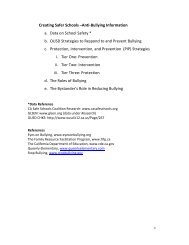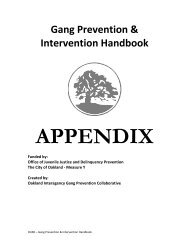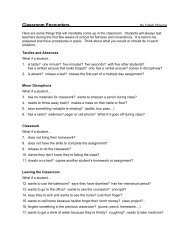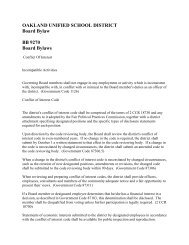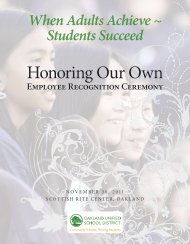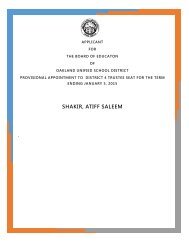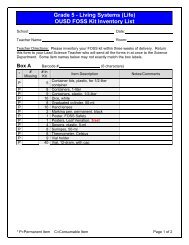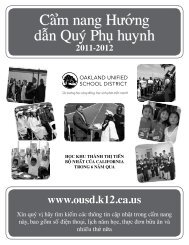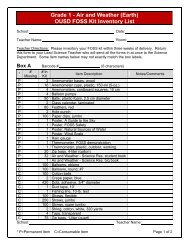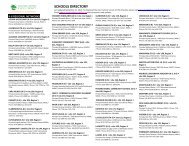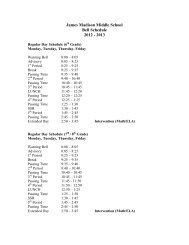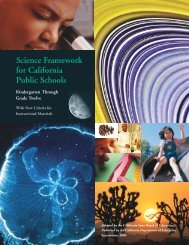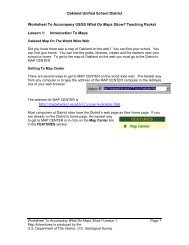Oakland Unified School District Case Study
Oakland Unified School District Case Study
Oakland Unified School District Case Study
You also want an ePaper? Increase the reach of your titles
YUMPU automatically turns print PDFs into web optimized ePapers that Google loves.
practice. Staff members felt this was much<br />
more powerful than “coming in with a<br />
bunch of checklists,” and contend that the<br />
process was extremely helpful in advancing<br />
their thinking.<br />
AWE has improved not only its instructional<br />
capacity through the strategic use<br />
of coaches, but many feel that coaching<br />
has played an important role in developing<br />
the leadership capacity of the school.<br />
Many teachers celebrate Kean’s leadership<br />
style, as it is characterized as “very positive,<br />
focused on instruction, collaborative, relying<br />
on different groups and structures and<br />
coaching” but acknowledge that her style<br />
has changed slightly over the years. Teachers<br />
feel that Kean is reflective and open to<br />
growing, and the BayCES coaching has<br />
helped her see where she can improve. Kean<br />
made a similar observation about her own<br />
practice:<br />
I’ve always had tremendous<br />
coaching. I had a data coach, a<br />
New Leaders [New Leaders for<br />
New <strong>School</strong>s] coach, and a BayCES<br />
coach. The BayCES coach forced us<br />
to think about how the system must<br />
work to create equity. If we said<br />
we were about equity they would<br />
question me how come there were<br />
always three African-American boys<br />
sitting in the office each visit.<br />
For 2008-09 the BayCES coach will be<br />
a half-time position, and Kean noted the<br />
importance of the district finding personnel<br />
who were thought partners for school<br />
leaders, given the reduction in BayCES<br />
coaching.<br />
Kean has also imparted the lessons<br />
she has learned from her coach to the<br />
team of instructional coaches at her site.<br />
Acknowledging that coaches often need<br />
coaching, she has developed a protocol<br />
that she uses with her coaches. During<br />
the sessions the coaches sit together and<br />
think through dilemmas and challenges<br />
and possible responses. This is another key<br />
structure for collaborative improvement<br />
and sharing expertise. Many coaches find<br />
this activity useful in their own professional<br />
development.<br />
Kean’s investment in teaching has created<br />
a cadre of coaches who worked to make<br />
significant changes in the curriculum last<br />
year. All teachers accessed coach expertise<br />
in particular focus areas: ELA instruction<br />
and English Language Development. Where<br />
these subjects overlap, integrated coaching<br />
was provided to teachers. Coaching was<br />
differentiated based on need, with newer<br />
and/or struggling teachers receiving more<br />
intensive support and more experienced<br />
teachers asked to share best practice. In addition<br />
to implementing coaching cycles, all<br />
instructional coaches, including the principal,<br />
are directly involved in teaching small<br />
reading and/or intervention groups on a<br />
weekly basis.<br />
AWE teachers use a results-driven collaboration<br />
model. Collaboration is built into<br />
the school day and takes place one hour per<br />
week. It is structured each week for teachers<br />
to collaboratively plan units, analyze<br />
data, and engage in protocols for the purpose<br />
of adjusting instructional practice.<br />
Essential to the collaboration hour is a<br />
focus on students, their learning experiences<br />
and achievement. An instructional<br />
coach is present at all circuit collaboration<br />
meetings. In addition to collaborative<br />
planning, all teachers receive the benefit of<br />
a focused-peer observation cycle in which<br />
they get feedback on practices from at least<br />
one teacher colleague.<br />
OUSD <strong>Case</strong> <strong>Study</strong>: ACORN Woodland Elementary 17



